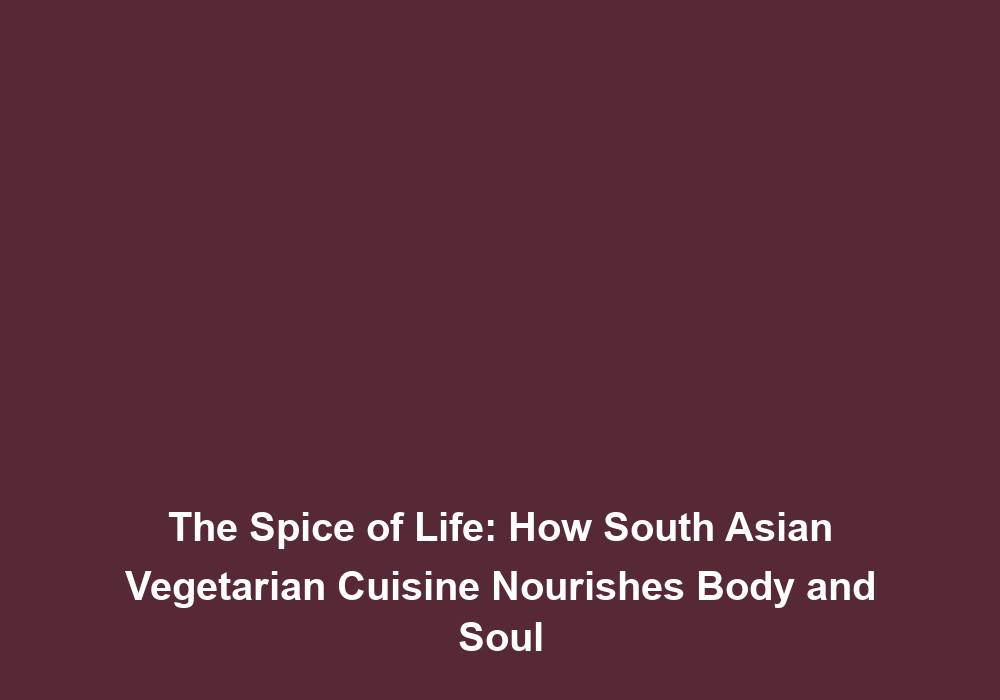The Spice of Life: How South Asian Vegetarian Cuisine Nourishes Body and Soul
South Asian vegetarian cuisine holds a special place in the hearts and palates of millions around the world. With its vibrant colors, aromatic flavors, and rich cultural heritage, this cuisine not only satisfies the taste buds but also nourishes both the body and soul. In this article, we will explore the health benefits, ingredients, and cooking techniques that make South Asian vegetarian cuisine a true delight.
The Health Benefits of South Asian Vegetarian Cuisine
-
Nutrient-Rich Ingredients: South Asian vegetarian dishes are often packed with a wide array of nutrient-rich ingredients, making them a powerhouse of vitamins, minerals, and antioxidants necessary for a healthy lifestyle. Lentils, legumes, fresh vegetables, and aromatic spices are commonly used, providing essential nutrients to support overall well-being.
- Lentils are a great source of protein, fiber, and iron, making them an ideal choice for vegetarians looking to meet their nutritional needs. They also contain folate, which is essential for cell growth and development.
- Legumes like chickpeas and beans are not only rich in protein but also provide essential vitamins and minerals such as potassium, magnesium, and folate. They are also a good source of dietary fiber, promoting digestive health.
- Fresh vegetables, such as spinach, eggplant, and okra, offer a wide range of vitamins and minerals. They are low in calories and high in fiber, making them an excellent choice for weight management and maintaining a healthy digestive system.
- Aromatic spices like turmeric and ginger not only add flavor to dishes but also contain compounds with anti-inflammatory and antioxidant properties. These spices have been linked to various health benefits, including reduced risk of chronic diseases.
-
Balanced Nutrition: South Asian vegetarian cuisine emphasizes a balance of proteins, carbohydrates, and fats, ensuring a well-rounded diet. Lentils, chickpeas, and beans serve as excellent sources of plant-based proteins, supporting muscle growth and repair. Whole grains like rice and wheat provide essential carbohydrates for energy, while healthy fats like ghee (clarified butter) and coconut oil contribute to a balanced diet.
- Including a variety of lentils and legumes in the diet ensures a complete protein profile, as different legumes contain different essential amino acids. This is particularly important for vegetarians to meet their protein needs.
- Whole grains like brown rice and whole wheat provide complex carbohydrates that are slowly digested, providing sustained energy throughout the day. They are also a good source of dietary fiber, aiding in digestion and promoting a feeling of fullness.
- Healthy fats like ghee and coconut oil provide essential fatty acids and fat-soluble vitamins. They also add richness and depth of flavor to South Asian vegetarian dishes.
-
Low in Saturated Fats: South Asian vegetarian cuisine is naturally low in saturated fats, making it a heart-healthy choice. Instead of relying on animal fats, dishes often incorporate plant-based oils and ingredients that promote good cholesterol levels.
- The use of plant-based oils like mustard oil, sesame oil, and coconut oil in South Asian vegetarian cuisine provides unsaturated fats that can help lower bad cholesterol levels and reduce the risk of heart disease.
- Nuts and seeds, such as almonds and flaxseeds, are often used in South Asian dishes, adding healthy fats and essential nutrients. These ingredients contribute to a well-balanced diet and promote overall heart health.
-
Fiber-Rich: The incorporation of whole grains, legumes, and fresh vegetables in South Asian vegetarian dishes means they are naturally high in dietary fiber. This not only aids in digestion but also helps maintain healthy blood sugar levels and lowers the risk of cardiovascular diseases.
- Dietary fiber plays a crucial role in maintaining a healthy digestive system by promoting regular bowel movements and preventing constipation.
- It also helps regulate blood sugar levels by slowing down the absorption of sugars into the bloodstream, preventing spikes and crashes in energy levels.
- High-fiber diets have been associated with a reduced risk of cardiovascular diseases, including heart disease and stroke.
-
Reduced Risk of Chronic Diseases: Research suggests that consuming a plant-based diet, like South Asian vegetarian cuisine, can lower the risk of chronic diseases such as heart disease, type 2 diabetes, and certain types of cancers. The abundance of antioxidants and anti-inflammatory compounds found in spices like turmeric and ginger further contributes to these health benefits.
- Plant-based diets are typically rich in antioxidants, which help protect the body against oxidative stress and reduce the risk of chronic diseases.
- The anti-inflammatory properties of spices like turmeric and ginger have been linked to a reduced risk of diseases associated with chronic inflammation, such as arthritis and certain types of cancers.
- Consuming a variety of fruits, vegetables, legumes, and whole grains provides a wide range of beneficial compounds that support overall health and well-being.
Key Ingredients in South Asian Vegetarian Cuisine
South Asian vegetarian cuisine derives its unique flavors from a range of distinctive ingredients. Let’s explore some of the key ingredients that give this cuisine its delicious appeal:
-
Spices: Spices are the heart and soul of South Asian vegetarian cuisine. From the fiery heat of chili peppers to the warm aromas of cumin, coriander, and cardamom, spices play an integral role in creating the signature flavors. Not only do they add taste, but many spices also have medicinal properties, making them a valuable addition to any diet.
- Chili peppers, such as cayenne and Kashmiri chili, not only add heat to dishes but also contain capsaicin, a compound known for its anti-inflammatory and metabolism-boosting properties.
- Cumin, coriander, and cardamom are commonly used spices that not only enhance the flavors of dishes but also offer various health benefits. For example, cumin aids digestion, coriander has antioxidant properties, and cardamom promotes healthy digestion and freshens breath.
-
Lentils & Legumes: Lentils and legumes are a staple in South Asian vegetarian cooking. These protein-packed ingredients not only add texture and flavor to dishes but also provide essential nutrients. From comforting lentil curries to savory bean stews, lentils and legumes are versatile and form the basis of many traditional recipes.
- Lentils come in various colors and sizes, such as red lentils, green lentils, and black lentils. Each variety offers a unique taste and texture, making them suitable for a wide range of dishes.
- Legumes like chickpeas, black beans, and kidney beans are commonly used in South Asian vegetarian cuisine. They are not only high in protein but also provide dietary fiber, folate, and iron.
-
Fresh Vegetables: South Asian vegetarian cuisine celebrates the abundance of fresh vegetables available throughout the region. From leafy greens like spinach and fenugreek to vibrant eggplants and okra, vegetables are cooked in a myriad of ways – stir-fried, sautéed, or curried. This ensures a wide variety of nutrients and flavors in every dish.
- Spinach is a nutrient-dense leafy green that is rich in iron, calcium, and vitamins A and C. It is often used in curries, stir-fries, and lentil dishes.
- Eggplants are a versatile vegetable that absorbs flavors well and adds a meaty texture to dishes. They are a good source of dietary fiber, potassium, and antioxidants.
- Okra, also known as lady’s finger, is often used in South Asian vegetarian cuisine due to its unique texture and taste. It is a good source of dietary fiber, vitamins, and minerals.
-
Grains: Rice and wheat are the primary grains used in South Asian vegetarian cuisine. Basmati rice, known for its fragrant aroma and long grains, is a staple in many households. Wheat, in the form of rotis (flatbreads) and parathas (layered bread), provides energy and is often enjoyed alongside curries and lentil dishes.
- Basmati rice is known for its low glycemic index, which means it does not cause a rapid increase in blood sugar levels. It is also a good source of vitamins and minerals, such as thiamine and niacin.
- Whole wheat rotis and parathas are made from whole wheat flour, which retains the bran and germ, making them a good source of dietary fiber and essential nutrients.
Cooking Techniques in South Asian Vegetarian Cuisine
-
Tempering: Tempering is a crucial technique used in South Asian vegetarian cuisine. It involves heating oil or ghee and adding spices such as cumin seeds, mustard seeds, and curry leaves to release their flavors before incorporating them into the dish. This process enhances the aroma and taste of the final result.
- Tempering spices in hot oil or ghee helps unlock their flavors and aromas, infusing the dish with a burst of taste.
- The order in which spices are added during tempering can vary, depending on the desired flavor profile. For example, adding mustard seeds first can provide a nutty and slightly bitter taste, while adding cumin seeds first can give a warm and earthy flavor.
-
Slow Cooking: Many South Asian vegetarian dishes benefit from slow cooking methods. This allows the flavors to meld together and intensify over time. Slow cooking also ensures that vegetables are cooked to perfection, resulting in tender and flavorful dishes.
- Slow cooking allows the ingredients to release their flavors gradually, resulting in rich and complex tastes.
- It also helps tenderize tougher vegetables and legumes, ensuring that they are soft and easily digestible.
- Simmering dishes over low heat for an extended period of time allows the spices and herbs to infuse into the dish, enhancing the overall flavor profile.
-
One-Pot Meals: South Asian vegetarian cuisine often features one-pot meals, such as biryanis and pulao. These dishes combine rice, vegetables, and spices, creating a complete and flavorful meal in a single pot. This cooking technique not only simplifies the cooking process but also enhances the overall taste.
- One-pot meals are convenient, as they require minimal preparation and clean-up. They are perfect for busy individuals or those looking for quick and easy meal options.
- The combination of rice, vegetables, and spices in one pot allows the flavors to meld together, resulting in a harmonious and balanced dish.
- The technique of layering ingredients in a specific order ensures that each component is cooked perfectly, with the rice being fluffy and the vegetables tender.
-
Fermentation: Fermentation is another technique used in South Asian vegetarian cuisine, particularly in the preparation of condiments like pickles and chutneys. Fermented foods not only add tang and depth to meals but also offer probiotics that promote a healthy gut.
- Fermentation involves the breakdown of carbohydrates by microorganisms, resulting in the production of lactic acid. This process imparts a sour and tangy flavor to the food.
- Fermented foods like yogurt, pickles, and kimchi contain beneficial bacteria that support a healthy gut microbiome. These probiotics aid in digestion and promote overall gut health.
- The process of fermentation also increases the bioavailability of certain nutrients, making them easier for the body to absorb.
Conclusion
South Asian vegetarian cuisine is a treasure trove of flavors, colors, and health benefits. With its nutrient-rich ingredients, balanced nutrition, and unique cooking techniques, it offers a holistic approach to nourishing both the body and soul. Whether you are a vegetarian, an aspiring chef, or simply someone looking to explore new culinary horizons, South Asian vegetarian cuisine is a delightful journey awaiting your palate.
Note: The content generated above is in markdown format.







